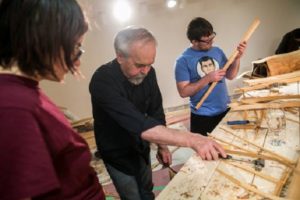Internationally-renowned Algonquin craftsman guides Carleton University students on Birch Bark Canoe building

By Rick Garrick
OTTAWA—Carleton University students are busy with the construction of a traditional Algonquin canoe under the direction of Pinock, an internationally-renowned Algonquin craftsman from Kitigan Zibi Anishinabeg Nation.
“I really enjoy working with Pinock,” shared Summer-Harmony Twenish, a second-year Carleton student from Kitigan Zibi. “He is a very patient teacher, and any mistakes made are quickly fixed because he has been working with canoes for so long.”
Twenish says she grew up around the materials they are using, which include birch, ash, and cedar, to make the canoe because her grandmother used to make canoes, baskets, and other items. Pinock brought in all the materials, which he had previously harvested, for the project.
“It was interesting to see everything used for a canoe of this size,” Twenish says. “It is also interesting to see how few materials are used, and to see something so beautiful form so quickly — it has only been four weeks of the workshop so far.”
Carleton’s Centre for Aboriginal Culture and Education (CACE) and the Carleton University Art Gallery (CUAG) are collaborating on the project to help celebrate Carleton’s 75th anniversary. The project began on Feb. 1, with workshops scheduled for every Wednesday evening at the CUAG until late March. About 10 students are participating on a regular basis in the project.
“The students are going to make an eight-to-10-foot birch bark canoe,” says Benny Michaud, Aboriginal cultural liaison officer with CACE. “This is the first time we ever put on a workshop like this. We are really excited in the approach that Pinock has taken with the students. He’s invited students to help him build the canoe from beginning to end. He is involving students in every process.”
Twenish joined the project as a way to reconnect to her cultural roots as an Anishinabekwe from Kitigan Zibi.
“When I applied for the workshop, I did it with the intention of learning something I never got to learn from my grandmother before she passed away,” Twenish says. “While doing the workshop, Pinock brought in photo albums and I ended up coming across a photograph of my grandmother, which was so humbling and reassuring.”
Twenish says the participants who are working on the canoe project are both Indigenous and non-Indigenous students and faculty.
“This project not only educates but also fosters relationships between both groups,” Twenish says. “It also pays homage to the traditional caretakers of this land called Ottawa.”
When the canoe is completed, it will be tested in the water and then it will be installed next Fall in a prominent place on the main floor of Carleton’s MacOdrum Library.
“It is a high traffic area in the university,” Michaud says. “It is at the center of campus so there will be a lot of opportunity for students to pass by the canoe and to read the plaque that will explain the reason that the canoe was built.”
Michaud says Carleton, and particularly the Centre for Aboriginal Culture and Education, are working to acknowledge the Truth and Reconciliation Commission’s Calls to Action around education.
“One of those Calls to Action is to provide relevant learning opportunities, so a priority for us is to integrate Indigenous perspectives and Indigenous ways of knowing and learning in classrooms, but also in some of the activities that we fund to take place for students,” Michaud says.


